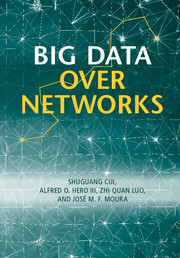Book contents
- Frontmatter
- Contents
- List of contributors
- Preface
- Part I Mathematical foundations
- 1 Tensor models: solution methods and applications
- 2 Sparsity-aware distributed learning
- 3 Optimization algorithms for big data with application in wireless networks
- 4 A unified distributed algorithm for non-cooperative games
- Part II Big data over cyber networks
- Part III Big data over social networks
- Part IV Big data over biological networks
- Index
- References
2 - Sparsity-aware distributed learning
from Part I - Mathematical foundations
Published online by Cambridge University Press: 18 December 2015
- Frontmatter
- Contents
- List of contributors
- Preface
- Part I Mathematical foundations
- 1 Tensor models: solution methods and applications
- 2 Sparsity-aware distributed learning
- 3 Optimization algorithms for big data with application in wireless networks
- 4 A unified distributed algorithm for non-cooperative games
- Part II Big data over cyber networks
- Part III Big data over social networks
- Part IV Big data over biological networks
- Index
- References
Summary
In this chapter, the problem of sparsity-aware distributed learning is studied. In particular, we consider the setup of an ad-hoc network, the nodes of which are tasked to estimate, in a collaborative way, a sparse parameter vector of interest. Both batch and online algorithms will be discussed. In the batch learning context, the distributed LASSO algorithm and a distributed greedy technique will be presented. Furthermore, an LMS-based sparsity promoting algorithm, revolving around the l1 norm, as well as a greedy distributed LMS will be discussed. Moreover, a set-theoretic sparsity promoting distributed technique will be examined. Finally, the performance of the presented algorithms will be validated in several scenarios.
Introduction
The volume of data captured worldwide is growing at an exponential rate posing certain challenges regarding their processing and analysis. Data mining, regression, and prediction/forecasting have played a leading role in learning insights and extracting useful information from raw data. The employment of such techniques covers a wide range of applications in several areas such as biomedical, econometrics, forecasting sales models, content preference, etc. The massive amount of data produced together with their increased complexity (new types of data emerge) as well as their involvement in the Internet of Things [1] paradigm call for further advances in already established machine learning techniques in order to cope with the new challenges.
Even though data tend to live in high-dimensional spaces, they often exhibit a high degree of redundancy; that is, their useful information can be represented by using a number of attributes much lower compared to their original dimensionality. Often, this redundancy can be effectively exploited by treating the data in a transformed domain, in which they can be represented by sparse models; that is, models comprising a few nonzero parameters. Besides, sparsity is an attribute that is met in a plethora of models, modeling natural signals, since nature tends to be parsimonious. Such sparse structures can be effectively exploited in big data applications in order to reduce processing demands. The advent of compressed sensing led to novel theoretical as well as algorithmic tools, which can be efficiently employed for sparsity-aware learning, e.g. [2–7].
In many cases, processing of large amount of data is not only cumbersome but might be proved to be infeasible due to lack of processing power and/or of storage capabilities.
Information
- Type
- Chapter
- Information
- Big Data over Networks , pp. 37 - 65Publisher: Cambridge University PressPrint publication year: 2016
